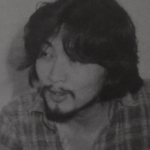
Tannai Tsukasa
Interviewer: How did you come to work on “Castle in the Sky”? How did Mr. Miyazaki approach you about it?
Initially, Mr. Miyazaki reached out to me around April of 1985, saying, “I’m going to make an animated movie.” I responded, “That sounds interesting. Please do your best.” I thought I might get a formal offer around August, though I did suspect it would be a challenging task.
Interviewer: So that’s how the request came about?
In mid-July, I received a call asking if I could work on it. Although I had planned to decline, I was persuaded with arguments like “Aren’t you going to build it brick by brick?” and “You’re not a man if you don’t do it” (laughs), so I decided to give it a try. I had worked with Miyazaki on two episodes of the new “Lupin the Third” series (“Albatross: Wings of Death” and “Farewell Beloved Lupin,” both directed by Hayao Miyazaki, with Tsukasa Tanai as animation director), so I was familiar with his review process.
Interviewer: How do you find Mr. Miyazaki’s characters, from an animator’s perspective?
Mr. Miyazaki’s characters have certain nuances that make them difficult. I created a complex character chart, but the storyboard and A Part of the storyboards were still incomplete, so we couldn’t finalize it before the key animation began. From the beginning, it was intended to be a draft to prepare for the key animation. We had the key animators draw based on that, corrected it in the animation director’s check, compiled the revised characters, and used it as a character chart for the key animators. It may have been challenging for the key animators.
Interviewer: Did you personally handle any cuts as key animator?
There are about thirty cuts. Pazu and Sheeta descend into the cave, a flashback to the valley of Gondoa. It continues until the scene where old man Pom appears and is seen off outside. I did it while waiting, as there was no work for the animation director until the key animation was up.
Interviewer: Mr. Miyazaki is a director from an animation background. Does he get quite involved in the key animation checks himself?
In Mr. Miyazaki’s case, my role is akin to an assistant animation director. The director checks and adjusts the timing and movement of the key animation, organizes it, and sends it to in-between animation, so my job was mainly to focus on revisions. Still, being an animation director for a feature film for the first time came with a certain level of pressure, and the subtleties of the characters’ nuances were quite challenging.
Interviewer: You’ve mentioned the nuance of characters several times. Can you explain that?
The same character’s expressions subtly change depending on the scene and the feelings they’re experiencing. For example, in the case of Dola, she’s a villain in the first half, an energetic old woman in the middle, and a good person at the end… changing the expression shown in each scene. Laughing, crying, bearing teeth – these are still easy. The subtly of everyday expressions in Mr. Miyazaki’s characters are extremely difficult.

Interviewer: Who is your favorite character to draw?
I find Dola’s family easiest to draw. It’s fun to draw them, and their performances are interesting. The sons, their feelings are blatantly obvious (laughs). Their emotions are so clear, so they are easy to draw. Muska was also interesting because he’s not a typical villain. He developed a somewhat crazed demeanor towards the end.
Interviewer: Between action and everyday acting, which do you prefer?
Everyday acting can be boring on its own, but if it’s properly portrayed in a film, the action scenes come alive. The whole flow of the film can expand if acting is incorporated. It’s hard to choose between the two. I personally find manga-like scenes more entertaining (laughs).
Interviewer: What was the pace like for the key animation?
In the first half, there were many people working with Mr. Miyazaki for the first time, so it seemed quite challenging. But from the middle, they got a grasp of the film’s image and the work progressed well. The benefit of having the director, Mr. Miyazaki, able to quickly review, and having the key animation, in-between animation, finishing, and art done in one place, was significant.
Interviewer: What kind of animation would you like to work on in the future?
I don’t have anything specific in mind, but I do have children, so I’d like to work on projects that suit their age. In the past, I was amazed by the works created by Mr. Takahata and Mr. Miyazaki, thinking, “Wow, such anime exists.” I find “Heidi, Girl of the Alps” interesting as a film rather than an anime. I believe it’s best to create something that’s interesting as a film.
Tsukasa Tannai, born in 1954, has participated as a main staff member in works directed by Isao Takahata and Hayao Miyazaki such as “Lupin the Third: The Castle of Cagliostro,” “Jarinko Chie,” “Sherlock Hound,” “Nausicaä of the Valley of the Wind,” and “My Neighbor Totoro.” Recently, he has been active primarily in “Ojarumaru.”